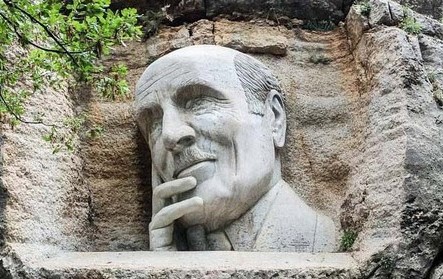
18 Jan .
7 Min Read .
2544


Mikhail Naimy 1889 – 1988
This is the welcoming rock-sign to
Mikhail Naimy’s mausoleum in his Shakhroub land at the foothills of Mountain
Sannine.
This path takes the visitor to the
mausoleum, a path to Mikhail Naimy’s world of thought and spirit, perhaps a
path that leads to the self, or even to a higher self engraved in the memory of
life.
The path leads to Mikhail Naimy’s
head and shoulder statue which is 3.4 meters high, 2.5 meters deep, and 3
meters wide within the general width of 7 meters. Next to the statue lies the
door that closes on the body of the thinker. All were sculpted in 1999 by the
three Assaf brothers: Assaf Assaf,
Mansour Assaf, and Aref Assaf.
Comprehensively funded and
created by Nadeem Naimy, The Mikhail Naimy mausoleum project started on May 1st,
1999. On that day, the Assaf brothers
moved to the ancestors home of Shakhroub – that was renovated by Mikhail Naimy
in the 1940’s – and stayed there until September 7, 1999, the day of the
mausoleum completion. On September 9,
1999, the official inauguration took place, and it was attended by Mr. Michel
Semaha, the Minister of Culture back then, as well as a host of public cultural
artistic social figures, all covered by the different media.
The Assaf brothers
emulated the cover photo of Prof. Nadeem Naimy’s book Tareeq Az-Zat Ela’Zat
(The Path to the Wider Self), a book that documents Mikhail Naimy’s life,
as if Nadeem Naimy is archiving his uncle’s philosophy in the records of
Shakhroub nature, eternizing the land.
Nadeem Naimy, a professor of philosophy at the American
University of Beirut (AUB), expressed his own philosophy of love and bond
towards his uncle Mikhail through the megaannum Shakhroub rock with Mikhail
Naimy’s slightly tilted head, supported by his left hand, looking with serenity
and bliss ahead at life, within and beyond its visible borders.
Through Mikhail Naimy’s philosophy of
transcendence, the person is wider and farther than his and her direct burdens
of the mundane. The human objectives are
to melt in the One Light, the source of every form of Light and Life.
Mikhail
Naimy paved the path of his nephew Nadeem Najeeb Naimy for a ‘wider self’, a
self that reached beyond the ever-changing temporality. Similarly, it is the time for Nadeem Naimy to
pave the path for Mikhail-Naimy-Mausoleum visitors for ‘a wider self’. The visitor treads the path that pours into
the wider area, the area of the engraved statue and the door behind which the
remains of Mikhail Naimy rest. In that
wider space, there is a remarkable symbiotic relationship between Mikhail
Naimy’s concepts of God, creation and beauty with the surrounding nature and
perfection. This relationship oozes a
noticeable form of peace and harmony.
Because of the osmotic
quality of bond between Mikhail Naimy and creation, between Mikhail Naimy and
God, Nadeem Naimy selected these lines to be inscribed on the door-like epitaph
from Mikhail Naimy’s book of prayer Najwa’l Ghouroub (Soliloquy to the Sunset),
published in 1973. Mikhail
Naimy raises meditation, prayer and praise to God, as his years approach their
setting.
طفلك أنا يا ربي
وهدْه الأرض
البديعة الكريمة الحنون
التي وضعتني في حضنها
ليست سوى المهد
أدرج منه إليك
I am Your infant my Lord
And this exquisite
generous tender land
In whose bosom you have
placed me
Is but the cradle
From which I step into you
The door is left ajar because it is
time for Mikhail Naimy to leave this world for the other. He is not the only one. Many have preceded and many will
succeed. There is a constant movement of
stepping in and out of this life to the next and vice versa, eroding the
doorstep of that door.
Mikhail
Naimy believed in reincarnation. Reincarnation
is the answer to the varied levels of awareness. Some people’s souls are mostly animalistic
while others’ are purely humanistic.
Naimy relates this fact to the number of lives the soul has
experienced: the more the lives, the
better the filtering to the soul, the deeper the awakening, and the wider the
self.
In
other words, according to Mikhail Naimy, life truths can be simulated through a
pyramid: the majority of the people,
with their instinctive motors and temporal drawn worries, are at the base. The higher the humans climb the pyramid, the
more challenging the transcendence, therefore the less the companions, until an
eclectic few reach the one point, the one God, on top of the pyramid. As people ascend the pyramid, they obtain a
better wider scenery, since they are at an elevated pedestal; they are able to
unveil what the people below are oblivious of.
The higher the level, the clearer
the view, and the wider the self.
On
the eroded doorstep, Mikhail Naimy deposited his book, along with his pen, and
a twig of oak. These will not be needed
in this life anymore as Naimy crosses to the afterlife. Plucked from Shakhroub - the land of oak - the
oak twig lays anaesthetized and purposeless.
On
the book, these lines are written:
تلك الوليمة يا قلمي
تنتهي عند أعتابها مهمتك
That banquet, my pen,
Ends at its doorsteps your mission
The pen’s mission is now annulled, as
this life banquet fades…
Nadeem Naimy has rendered
Mikhail Naimy’s mausoleum in Shakhroub, Sannine, an exquisite experience. The visitor is the pen that writes its own
word in the world of Mikhail Naimy, a synergy between the physical and the
metaphysical, a journey to the wider self.
As Mikhail Naimy once wrote, “Once I
am always I am.”
Suha Naimy
